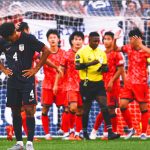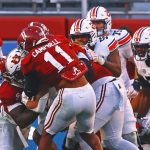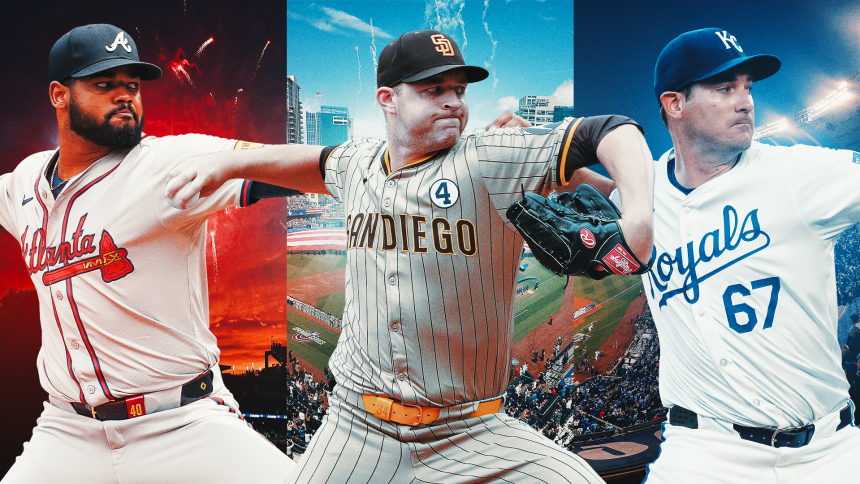On the same night Royals All-Star Seth Lugo struck out 10 batters in seven scoreless innings in the Bronx, fellow first-time All-Star and recently converted reliever Reynaldo López left his start with an injury after just one inning.
Tuesday night’s juxtaposition comes down the stretch of a 2024 season that has seen a spate of successful transitions from the bullpen to the rotation. Many of this year’s top relievers-turned-starters are still being let loose as they progress further into uncharted territory from an innings standpoint while excelling as rotation linchpins for playoff contenders.
The question, as October approaches, is how long it can last.
For the Braves, they hope their success story didn’t come to an end Tuesday night at Nationals Park.
ADVERTISEMENT
Among pitchers who’ve thrown at least 100 innings this year, none have a lower ERA than López — a particularly notable accomplishment considering this is the 30-year-old veteran’s first season as a full-time starter since 2020. He has already pitched nearly as many innings this year as his past two seasons combined, but even after a few-week stint on the injured list last month due to forearm inflammation, he didn’t seem to be wearing down.
He returned with authority, posting a 1.96 ERA with 34 strikeouts in 23 innings over four starts before Tuesday night, when it again became evident again that something wasn’t right.
The transition to the rotation for hard-throwing relievers like López requires a mentality change. As a starter, López knew he could no longer sit in the high 90s in velocity the way he did as a full-time reliever. Still, he also knows he has that in the tank when he needs it. Chris Sale describes López’s ability as “throttle control.”
“One out, guy on second base, it’s like he flips that switch,” Sale explained. “It’s like, ‘OK, here’s 98, here comes my reliever stuff.'”
On Tuesday, for the first time, that switch was unavailable. López thought his first pitch of the night would register around 95 mph; instead, it clocked in at 89. His next fastball came in at 90.6, then 91.1. This time, he could no longer reach back for more. He battled through a 25-pitch first inning to keep the Nationals off the board, but his four-seamer was down nearly 4 mph from his season average.
Tightness in his shoulder was the culprit. Initial tests came back negative, but López was placed on the IL on Wednesday. As the playoffs draw closer, his early departure serves as a reminder of the uncertainty ahead as converted relievers across the sport trek further into the unknown.
While López’s outing was an ominous sign, however, Lugo’s was far more promising.
The 34-year-old Royals All-Star has become a poster boy and one of the catalysts for this year’s emergence of converted relievers after his successful metamorphosis last season, but it took patience to get to this point. For years, the waiting game agonized him.
After serving primarily as a starter his first two years in the majors, all but 12 of Lugo’s final 239 outings with the Mets came out of the bullpen. Each offseason, he would track potential openings, still believing he could crack into the rotation, readying himself for an opportunity that wouldn’t arrive.
“I always had the mindset of, ‘If I pitch well enough in the pen, I’ll get another shot to start,” Lugo told FOX Sports. “Then, I have a couple really good seasons, and it’s like, ‘Well, you’re too good in the pen to start.’ It’s like, ‘Hold on a second. That’s the opposite of what I’m trying to do.'”
It took a change of scenery to find a club that shared his confidence.
When the Padres gave Lugo the chance he sought last season, he didn’t let it go to waste. The veteran right-hander started each of his 26 appearances in San Diego and pitched 146.1 innings, the second most of any pitcher on the team and nearly as many innings as he had thrown the previous three years combined. He didn’t find the added workload too burdensome — the only time he spent on the IL was for a calf strain — and he noticed when he made the transition back to the rotation that his experience as a reliever helped him navigate through tough spots with traffic on the basepaths.
“I think that when a Lugo gets himself into situations, I feel like normal starters would just say, like, ‘OK, minimize here and then go six,'” said Michael King, who this year has made a similarly successful full-time transition from the bullpen to the rotation in San Diego. “Lugo’s like, ‘F that, I’m putting up a zero,’ and now that ERA keeps creeping lower.”
Lugo ended last year with a 3.57 ERA, then parlayed that into a two-year deal with an additional player option in Kansas City, where he has continued to ascend. Entering Wednesday, Lugo, who had never thrown more than 150 innings in a season prior to this year, leads the majors in innings pitched (and innings pitched per start). He is also tied for first in wins and ranks fifth in ERA among qualified starters.
This year, his triumphant transformation might have helped open a door for veteran relievers looking for a similar opportunity.
“I feel like just not giving up on the idea of starting is the hardest part,” Lugo said.
Lugo’s reliever-to-starter transition is not necessarily groundbreaking. Last year, Cole Ragans, Ronel Blanco, Cristopher Sánchez, Zack Littell and King were among the pitchers who made the move. In the 80s, there was Charlie Hough. In the 90s, there was David Wells and Derek Lowe.
All but three of a young Pedro Martínez’s 67 appearances with the Dodgers in 1992 and 1993 came in relief before he was traded to the Expos, where his Hall of Fame career took off. Johan Santana went from bouncing between both roles the first four years of his career to winning a Cy Young Award in year five. In 2010 and 2011, all 79 of Sale’s appearances came in relief before he transformed into a seven-time All-Star. The recently retired Adam Wainwright broke into the majors at 23, but he wasn’t a starter for the Cardinals until two years later. Even dating back to the late 50s, there was 36-year-old future Hall of Famer Hoyt Wilhelm, an All-Star reliever who, eight years into his career, led the majors with a 2.19 ERA in his first season pitching primarily as a starter.
What stands out about the 2024 season is the quantity of successful shifts. It has been a banner year for converted relievers, as evidenced by the multiple All-Star starting pitchers who were pitching out of the bullpen just a season ago, including Garrett Crochet, Ragans and López.
As Sale turns back the clock — he’s the front-runner to win his first Cy Young Award at age 35 — he’s pitching for a resilient Braves rotation that has kept Atlanta within striking distance of the postseason despite a cavalcade of injuries. The group has been lifted by two newcomers in Sale and López.
This year, after perfecting the command of his secondary pitches and increasing his whiff rate out of the bullpen, López felt better equipped to handle the rigors of starting than he was when he logged a 4.76 ERA as a full-time starter in the White Sox rotation from 2017 to 2020. He backed up that belief with a league-leading ERA before suffering Tuesday’s setback.
For all of this year’s positive examples, there are also cautionary tales of what can happen when a pitcher pushes himself past the brink.
Jordan Hicks had built a reputation as a hard-throwing reliever with erratic command after entering the league in 2018. He had only started eight of his 212 career appearances entering this year, but he knew when he got to free agency this offseason he would pursue starting opportunities. San Francisco gave him the chance.
For a while, the Giants‘ decision looked prudent.
Hicks had a 1.59 ERA at the end of April, but it gradually ascended from there. While he still had a sub-3.50 ERA at the end of June, he had already set a career high in innings, his command began to waver, and his fastball was losing steam. The Giants tried to ease his workload, shaving off innings where they could. In April, he logged three starts of at least six innings with only one run allowed. He wouldn’t go more than five innings in a start the rest of the year.
After allowing five runs on July 11, Hicks admitted that his body was “feeling it a little bit more than past seasons.” He would wake up feeling fine. A few innings into a start, the fatigue would hit. His legs felt heavy, and he could no longer reach back in the high 90s when he needed it. By the end of July, Hicks was back in the bullpen, where he served as an effective piece until landing on the IL with shoulder inflammation late last month.
There is no exact science as pitchers make the transition from the bullpen to the rotation and approach their career high in innings in the process.
It’s easier for cellar-dwellers like the White Sox to cut back on Crochet’s workload than it is for playoff hopefuls like the Braves or the Padres to do the same for López and King, whose production has been vital in stabilizing their respective staffs.
Somehow, King — despite setting his career high in innings more than two months ago — has only gotten better as the year has progressed.
From 2019 to 2023, he started just 19 of his 115 appearances with the Yankees. Even as he thrived out of the Yankees’ bullpen, though, he was still “begging” his team to start. He got nine opportunities to do so last season and logged a 2.21 ERA in those games, which gave him “a ton of confidence” that he could handle the full-time starting role that awaited him this year in San Diego.
“I got addicted to the adrenaline rush of that relief role, coming in in some big situations and the crowd’s going nuts and you know the game’s on the line,” King told FOX Sports. “But I always saw myself as a starter, and I think that was part of the reason why I was able to convince Aaron Boone last year to let me start because I felt like I had a starter’s repertoire in the bullpen. He always said, ‘Well, you’re so valuable in the bullpen, so it’s hard to take you out.’ I remember arguing, like, ‘If you put Gerrit Cole in the bullpen, he’d be so valuable in the bullpen it’d be hard to take him out.’
“You have these guys, like I was able to go multiple innings because I had four pitches and could get swing and miss on all four. I get that I’m, whatever, too valuable in the bullpen, but it’s because you have a starter in the bullpen. Once I was able to break him down a little bit, I felt like he was able to see what I saw.”
The Padres saw the same and made him the centerpiece of their return from the Yankees in exchange for Juan Soto this past offseason. Similar to what they did with Lugo last year, they gave King the full-time starting opportunity he never had on the East Coast. Between starts, King changed the way he prepared his body in an effort to handle the new workload.
“The day that I’m pitching is probably the easiest day on my body, besides probably the day before,” King said. “But my day one, day two, day three are all grinds because you’ve got to make sure you’re maintaining strength, whether it’s arm strength or body strength, being able to recover. It’s like, there’s so much that goes into it.”
In a season in which Padres rotation mainstays Yu Darvish and Joe Musgrove have made a combined 28 starts, King has made 27. Among all qualified starters, King ranks ninth in ERA with a team-leading 3.10 mark. Getting to this point required venturing into the unexplored.
After setting a career high with 104.2 innings pitched last year, King crossed that mark in early July. The All-Star break provided a short reprieve, but the Padres continued to let him go from there, admittedly unsure at the time of what the future would hold but willing to push forward.
“Now, 175 [innings pitched] is like a workhorse,” Padres manager Mike Schildt said in June, “and the correlation with the guys that get those innings versus the guys that get modified innings, and who actually ends up getting hurt, there doesn’t seem to be any real clarity to me between those two groups.”
Rather than shut him down, the Padres monitored King after each start to see how he was recovering and what his side sessions looked like. They would give him additional rest where they could, reading and reacting to the way he felt, monitoring him closely after stressful innings and only allowing him to go deep into games when he was efficient.
But, in the thick of a playoff race, the Padres are still riding him. And he’s rewarding them.
In the nine starts since he surpassed his career high in innings, King has a 2.26 ERA. He has surrendered two runs or fewer in 10 of his past 11 starts and has not gone on the IL this year, despite already having pitched more innings than the previous two seasons combined.
Like Lugo and López, King believes he’s better equipped at minimizing damage because of his past relief experience. Opponents are hitting .223 overall against King this year. With runners in scoring position, they’re batting .187.
“I know when I come in in a big situation, I’m putting up a zero,” King said. “I’m getting some swing and miss because I’ve been there.”
Both King and Lugo were unlike most relievers, who typically rely on one or two reliable pitches to get them through an outing. An extensive pitch mix has eased the transition and allowed both to navigate through a lineup multiple times more easily.
While King has five pitches he can turn to, Lugo has nearly double that. The Royals starter is constantly tinkering with his ever-evolving arsenal — a necessity for him, considering he lives in the low 90s. Last year, Lugo added a sweeper and another breaking ball that he described as a mix between a curveball and sweeper — Statcast logged the pitch as a slurve — to give him seven different offerings. This year, he placed more of an emphasis on developing his changeup and also added a cutter and splitter, giving him nine different pitches to flummox opponents.
At 34, a year after his move back to the rotation, he is an All-Star for the first time.
“When I was a full-time reliever, I had teams and coaches try to get me to minimize all these pitches,” Lugo said. “I was like, ‘I need these pitches, especially when I start.’ They’re like, ‘Oh, you’re not starting.’ I’m like, ‘Well, I will, though.'”
Over the past two seasons, Lugo backed up his self-belief. Last year, he demonstrated he could still be a competent starter. This year, the converted reliever is starring for a potential playoff rotation.
And he’s paying attention to the pitchers now following suit, hoping they can sustain that success the rest of the year.
“I’m also rooting for them, too,” Lugo said. “Most relievers out there, they have this label as ‘failed starter.’ Seeing other guys having success is cool. Hopefully, other pitchers in the league that want to be starters don’t give up on it.”
Rowan Kavner is an MLB writer for FOX Sports. He previously covered the L.A. Dodgers, LA Clippers and Dallas Cowboys. An LSU grad, Rowan was born in California, grew up in Texas, then moved back to the West Coast in 2014. Follow him on Twitter at @RowanKavner.
[Want great stories delivered right to your inbox? Create or log in to your FOX Sports account, follow leagues, teams and players to receive a personalized newsletter daily.]
recommended

Get more from Major League Baseball Follow your favorites to get information about games, news and more













